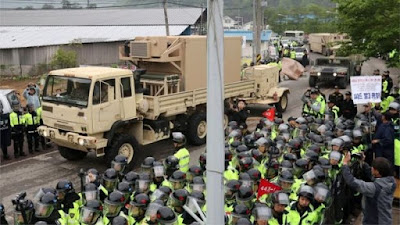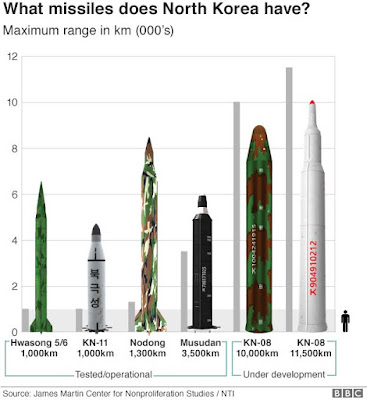The US says it plans to activate a missile defence system in South Korea "within days" and tighten economic sanctions against North Korea.
The announcements from the Trump administration come amid rising fears about the North's military advances.
The Thaad system was originally not expected to be in use until late 2017. Many South Koreans oppose it, fearing they will become a target.
North Korea has vowed to conduct more missile and nuclear tests.
Speaking to members of the US Congress on Wednesday, Adm Harry Harris, commander of the US Pacific Command, said Thaad would be "operational in the coming days to be able to better defend South Korea against the growing North Korea threat".
He has said the system is designed to bring North Korean leader Kim Jong-un "to his senses, not to his knees".
What is Thaad?
What is the Terminal High Altitude Area Defence System (Thaad)?
Shoots down short- and medium-range ballistic missiles in the terminal phase of their flight Uses hit-to-kill technology -
where kinetic energy destroys the incoming warhead Has a range of 200km (120 miles) and can reach an altitude of 150km US has previously deployed it in Guam and Hawaii as a measure against potential attacks from North Korea Deployment to South Korea was agreed by Obama administration

The arrival of the defence equipment at the Seongju site on Wednesday was met with protests by locals.
It has also angered China, which fears the system's radar capabilities will affect its own military security, and that it changes the balance of power in the region.
The Thaad deployment comes at a time of escalated fears of military action on the ever-tense Korean peninsula
After repeated missile tests by North Korea - including a failed ballistic missile test on 16 April - and threats of further nuclear tests, US Vice-President Mike Pence warned North Korea not to "test" President Donald Trump.
On Tuesday, a US submarine - the USS Michigan - joined a group of warships in the Korean peninsula led by aircraft carrier the USS Carl Vinson.
North Korea meanwhile threatened to sink the aircraft carrier and launch a "super-mighty pre-emptive strike" against what it called US aggression.
After a special briefing for all 100 US senators, top US officials announced President Donald Trump's strategy on North Korea.

"The president's approach aims to pressure North Korea into dismantling its nuclear, ballistic missile, and proliferation programs by tightening economic sanctions and pursuing diplomatic measures with our allies and regional partners," said a joint statement issued by Secretary of State Rex Tillerson, Defense Secretary Jim Mattis and Director of National Intelligence Dan Coats.
The US already has extensive sanctions in place on North Korea, including a blanket ban on trade and a blacklist of anyone dealing with North Korea.
A White House official said an option under consideration was to put North Korea back on the state department's list of countries that sponsor terrorism.
Under measures announced last year, North Korean government property in America remains frozen and US exports to, or investment in, North Korea are banned

The arrival of the defence equipment at the Seongju site on Wednesday was met with protests by locals.
It has also angered China, which fears the system's radar capabilities will affect its own military security, and that it changes the balance of power in the region.
The Thaad deployment comes at a time of escalated fears of military action on the ever-tense Korean peninsula
After repeated missile tests by North Korea - including a failed ballistic missile test on 16 April - and threats of further nuclear tests, US Vice-President Mike Pence warned North Korea not to "test" President Donald Trump.
On Tuesday, a US submarine - the USS Michigan - joined a group of warships in the Korean peninsula led by aircraft carrier the USS Carl Vinson.
North Korea meanwhile threatened to sink the aircraft carrier and launch a "super-mighty pre-emptive strike" against what it called US aggression.
After a special briefing for all 100 US senators, top US officials announced President Donald Trump's strategy on North Korea.

"The president's approach aims to pressure North Korea into dismantling its nuclear, ballistic missile, and proliferation programs by tightening economic sanctions and pursuing diplomatic measures with our allies and regional partners," said a joint statement issued by Secretary of State Rex Tillerson, Defense Secretary Jim Mattis and Director of National Intelligence Dan Coats.
The US already has extensive sanctions in place on North Korea, including a blanket ban on trade and a blacklist of anyone dealing with North Korea.
A White House official said an option under consideration was to put North Korea back on the state department's list of countries that sponsor terrorism.
Under measures announced last year, North Korean government property in America remains frozen and US exports to, or investment in, North Korea are banned

No comments:
Post a Comment